Summer Visits
SRA Summer Visit to the Archives of John Dewar and Sons Ltd, June 2024
On 24 June, seven members and guests of the Association spent a fascinating afternoon exploring the Archives of John Dewar & Sons Ltd, whisky manufacturers, located on the company's production site at 1700 London Road, Glasgow. We were welcomed by the Archivist, Samantha Case, who gave us an introductory talk on the history of the company and its records followed by a tour of the stores.
Samantha explained that the company was originally established in Perth in 1846, when John Dewar opened a wine and spirit shop on the High Street. He initially sold a range of products such as whisky, ale and wine, but later began blending and selling his own whisky and brought his two sons, John Alexander Dewar and Tommy Dewar, into the business. When they succeeded their father in the 1880s, John and Tommy vastly expanded sales and production, with Tommy embarking on a two-year, global marketing tour in 1892, journeying to no fewer than 26 countries. What was to become the company's flagship blend, DEWAR's White Label, was launched in 1899. Acquired by the Bacardi Group in 1998, Dewar's is the world's most awarded blended Scotch whisky.
As well as the records of John Dewar & Sons Ltd, the Archives hold the records of the Bacardi company's other whisky and gin brands: William Lawson Distillers Ltd; the Aberfeldy Distillery; Aultmore; Craigellachie; Macduff; Royal Brackla, and the Bombay Gin/Spirits Company. The collections encompass over 14,000 items, ranging from correspondence, minute books and staff records to photographs, posters, awards, and bottles. As might be expected, this material has provided inspiration for the company's branding, with the signature of John Dewar on its bottle labels being a notable example.
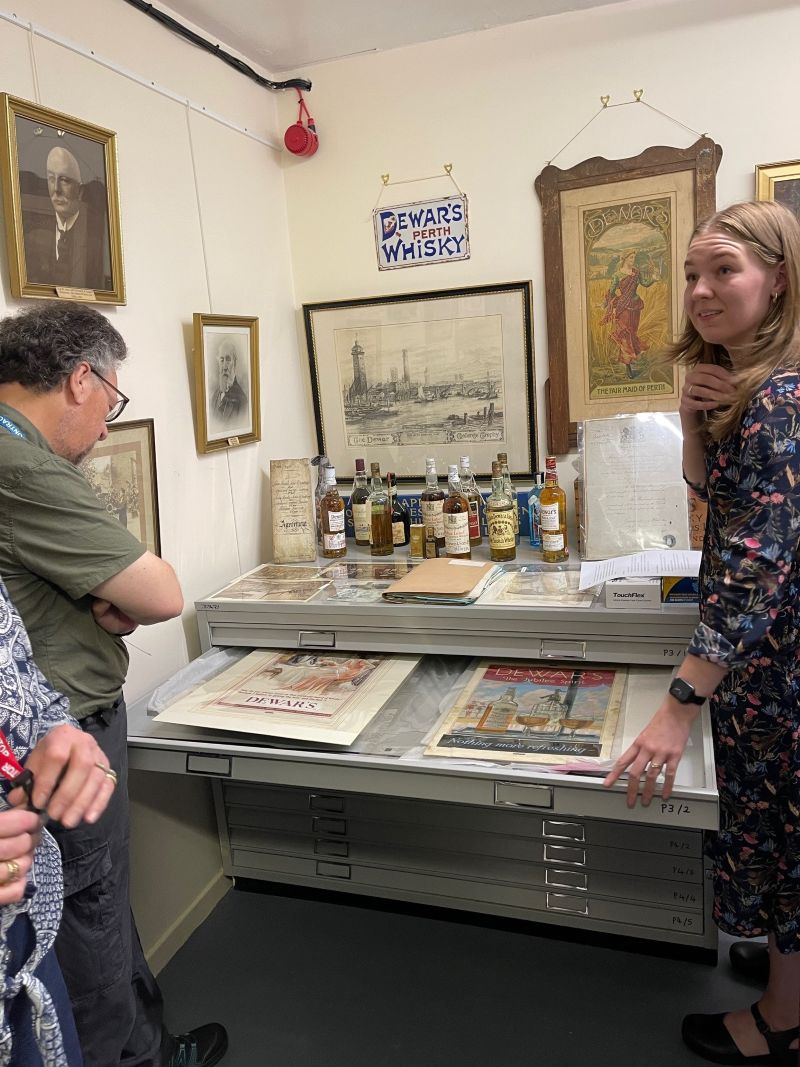
During our tour, we were privileged to view some of the Archives' many treasures, including cask stencils; original artwork for posters and other advertising materials from the 1930s and 1940s; and a whisky label book, which a commercial traveller would have carried to illustrate the company's range of products. We were particularly taken with some small, point-of-sale novelties dating from the early 1900s and featuring the company's branding, such as a tiny box resembling a book and containing a mini bottle of whisky and a pack of cards. We were also shown one of the Archives' latest acquisitions: a Victorian glass bar top decanter, complete with its original tap, branded 'Dewar's Whisky Perth' and intended for use in a public bar. Owing to its size and fragility, this item is a rare survival.
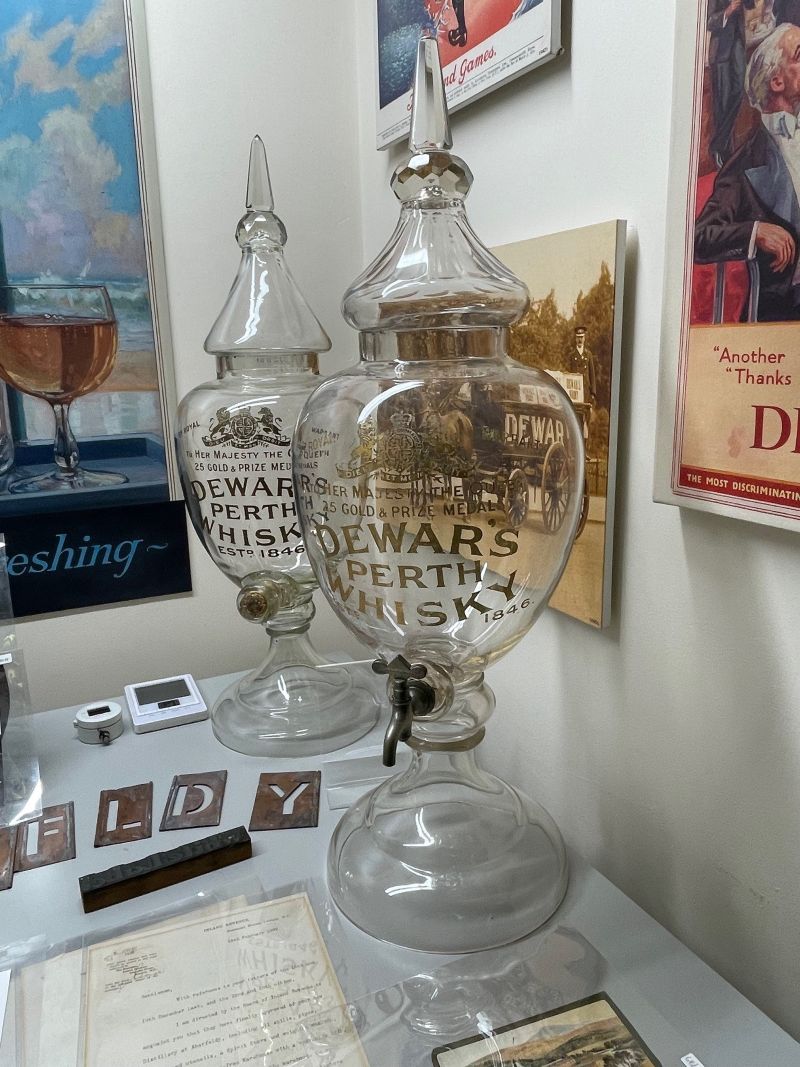
Our tour concluded in the Archives' bottle store, where we browsed a display of copper label printing plates, trade price lists, and historical packaging materials for the company's products, including straw-filled, branded wooden packing cases and wicker bottle baskets. This room contains a large and growing collection of unopened bottles of whiskies and spirits manufactured by the company and its subsidiaries over the years. The oldest Dewar's bottle in the collection dates from the 1880s; as Samantha pointed out, whisky bottles of this vintage were commonly made of coloured glass, unlike more modern, clear bottles. Sadly, no tastings were permitted (!), but members of the group were allowed to smell the contents of one (already open) bottle of Victoria Vat whisky, dating from the 1950s.
While the Archives of John Dewar & Sons Ltd are not generally open to the public, Samantha and her colleagues are able to answer enquiries by email (scase@bacardi.com). We are grateful to them for hosting our thoroughly enjoyable visit and for giving so generously of their time and expertise.
SRA Summer Visit to Stirling Council Archives, August 2023
On 25 August 2023, a small but enthusiastic group of six SRA members visited Stirling Council Archives, where we received an introductory talk and a tour of the store from the Council Archivist, Pam McNicol.
As Pam explained, Stirling Council Archives was originally the Central Regional Archive, established in 1975 in response to the Local Government (Scotland) Act. When the Scottish regions were reorganised in 1996, the Central region was abolished and local government functions within the area were assumed by the new Stirling Council. Since 2005, the Archives office, reading room and store have been situated in a former warehouse on the Springkerse Industrial Estate.
As one might expect, the Archives' core collections are local authority records, including:
- Stirling Burgh records, which date from the fourteenth century onwards and progress through the records of successor authorities, Stirling District Council and the current Council. They comprise charters, minutes, the Dean of Guild plan series and other records reflecting the Council's administrative activities.
- Records of the police burghs of Bridge of Allan, Callander, Dunblane and Doune, including minutes and property records.
- Stirling County Council records, which date from 1890 onwards and include School Board and Education Committee minutes and records relating to individual schools.
- Owing to boundary changes over the years, the Archives also holds some records for the Western district of Perthshire, stretching from Dunblane to Killin.
- Central Regional Council records, which date from 1975 onwards and include a variety of committee minutes and papers.
- Burial records for all the local authority administered cemeteries in the Stirling Council area.
- Post-1845 Poor Law records, including applications and registers of the poor. These are amongst the most frequently requested local authority materials in the Archives, being rich in social history and in details about individuals and families. Helpfully, many of the registers of the poor have now been indexed by volunteers.
Other highlights from the local authority collections include the records of Central Scotland Police, which date back to around 1860, and the customs and excise records for Alloa ports, which contain references to the activities of pirates and smugglers.
The Archives also holds many private collections that have been gifted or deposited over the years. These collections, which occupy one side of the store, are an eclectic mixture and include the estate papers of Murray of Polmaise, the estate papers of Stirling of Gargunnock, and the MacGregor of MacGregor collection. Other notable examples are the papers of local businesses, such as James Gray, seed merchant; the records of Whinwell Children's Home, and sets of local newspapers such as the Stirling Journal and Advertiser (published from 1820) and the Stirling Observer.
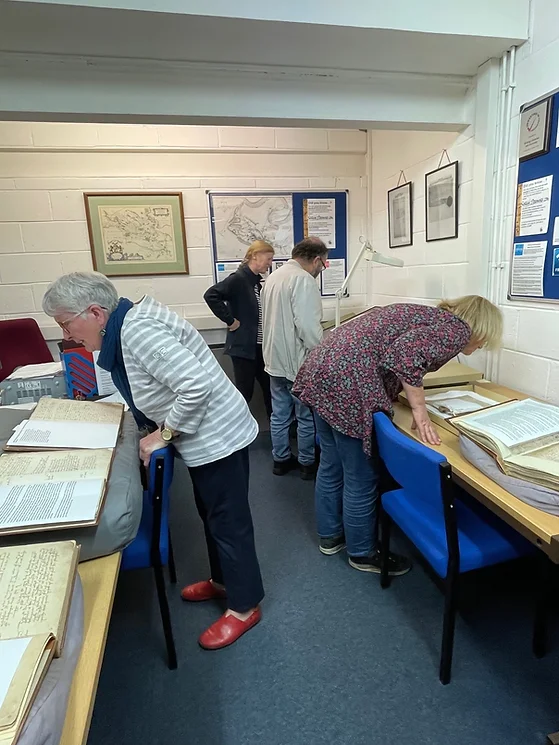
We concluded our fascinating afternoon by browsing a display of 'star' items selected for us by Pam. Amongst these was a Stirling Burgh Court Book dating from 1544-1550 (reference: SBC/37/1/2), which contains the first written evidence of the possession and discharge of a handgun in Scotland (9 May 1549). Also laid out for us was a letter written by Bonnie Prince Charlie on 1 January 1946, requesting the Provost, Magistrates and Town Council of Stirling to allow the Jacobite forces 'peaceable entry into and possession of' the town (reference: B66/25/335). From the Stirling County Council building plans collection, we admired two of Charles Rennie Mackintosh's plans for a house at Killearn, Stirlingshire, drawn in 1906 (reference: Stirling County Council plan series Western 14/1906), one of which is pictured below. The plans were commissioned by F.J. Shand, who went on to build the house as specified but later fell out with Mackintosh.
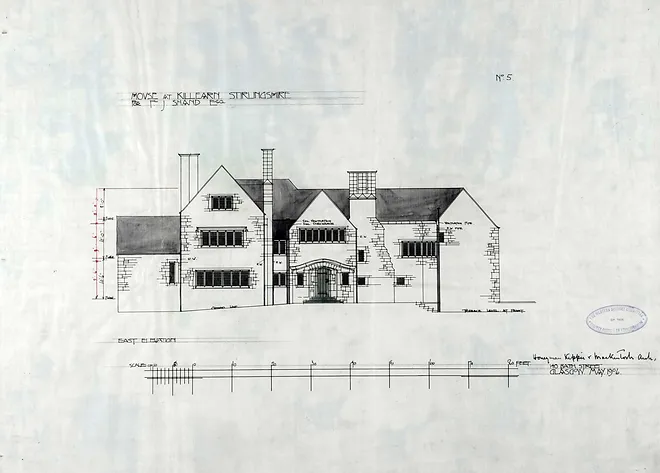
Finally, the group was impressed by a beautifully drawn plan from the Murray of Polmaise collection (reference: PD189RHP 3789), dating from some time in the eighteenth century and representing an early record of the roads and mills around Polmaise House, as well as the 'Bannock burn', pictured below.
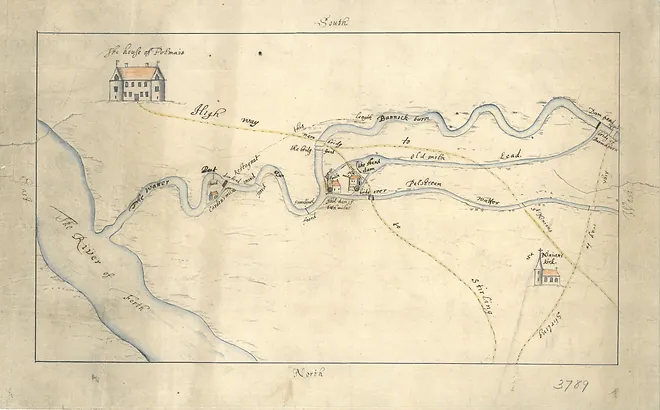
The Scottish Records Association would like to thank Pam McNicol for facilitating our visit and for giving so generously of her time, knowledge and enthusiasm.
SRA Summer Visit to Blair Castle Archives, June 2023
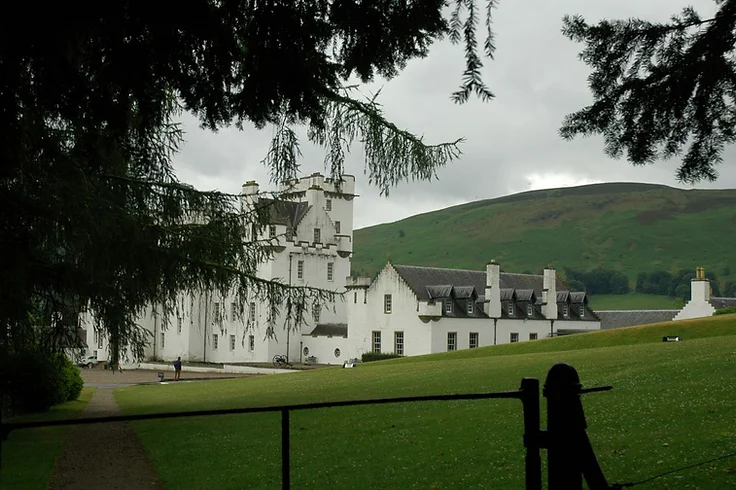
On 23 June 2023 a group of ten members and guests of the Scottish Records Association visited Blair Castle Archives in Pitlochry, Perthshire. Our host, Keren Guthrie, who looks after the castle's archive collections, artefacts and exhibitions as well as the records management for the Atholl Estates, began by giving us an introductory talk about the development and history of Blair Castle from its thirteenth-century origins up to the present day. As Keren explained, the castle has been home to 19 generations of the Stewart and Murray families, Earls of Atholl and, from 1703, Dukes of Atholl, whose eventful lives and political allegiances have shaped the castle's fortunes. In 1746, for example, Blair was the last castle on British soil to be besieged during the Jacobite rebellion.
We then received a guided tour of the archive facilities. As those who attended the Scottish Records Association's previous visit to Blair Castle Archives in 1997 may remember, the collections were formerly housed in the space between the castle kitchen and the north end boiler, with the searchroom located next to the cafe. However, several years ago the collections were moved to a new, specially designed facility, their relocation having been prompted by a fire that ravaged the castle's clock tower in 2011. While no other parts of the castle were affected and no artefacts or historical records were lost or damaged, the incident emphasised the importance and the vulnerability of the archives and the need to ensure their protection against future disasters. When the clock tower was rebuilt, it was reconstructed as an archive facility, with an office, a consultation room and two temperature- and humidity-controlled, double-skinned storerooms. Jane Anderson, Keren's predecessor as Archivist, helped to design the facility, including a simple but effective system of wall hooks for storing rolled plans, which impressed the professional archivists in our group!
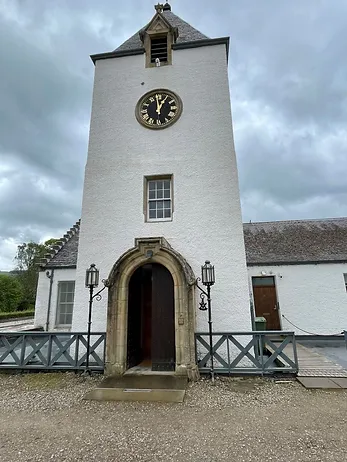
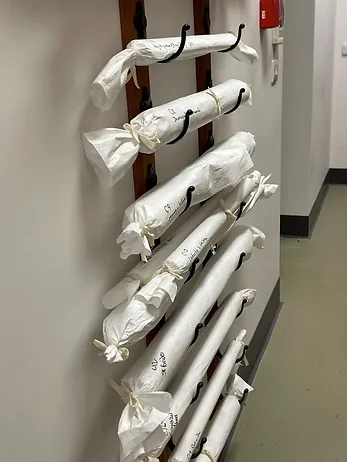
The oldest document in the Archives dates from 1262, and one of the tower's two storerooms is wholly devoted to records dating from before 1800, whilst the other holds post-1800 records. In the consultation room, Keren had laid out a variety of items from the collection for us to browse, including a set of the castle's household accounts dating from 1693-1713 and a mid-nineteenth century manuscript volume recording the activities of the Atholl Highlanders. Keren informed us that Queen Victoria and Prince Albert's renowned love of the Scottish Highlands had been kindled during the royal couple's extended stay at Blair in 1844, when the castle was put entirely at their disposal and the Duke of Atholl's men provided a guard to ensure their safety and privacy. So appreciative was the Queen of the service shown by the Duke's men that she granted them the right to carry her colours and to bear arms, thus creating the Atholl Highlanders. Reporting to the Duke of Atholl rather than to the monarch, the regiment is now the last remaining private army in Europe.
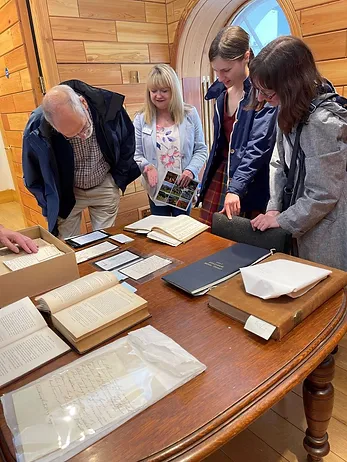
with some members of the SRA group

We also perused a selection of records reflecting the close friendship between Duchess Anne, wife of the 6th Duke of Atholl, and Queen Victoria. Anne was created Mistress of the Robes in 1852 and Lady of the Bedchamber in 1854, and the Archives contain many letters and other documents sent to her by the Queen, including a hand-drawn sketch showing how the Queen's train was to be carried by page boys, and a recipe for potato salad.
In 1936, Blair Castle became the first privately owned historic house in Scotland to open full-time to visitors. After a satisfying lunch of sandwiches, coffee and cakes, kindly provided by our hosts, we spent the remainder of the afternoon following in those visitors' footsteps and exploring the castle's well-appointed public rooms, in which stunning examples of historic fashion were displayed as part of the 'Castle Couture' exhibition. Undeterred by the wet weather, several members of the group then rounded off their enjoyable day with a walk around the gardens and grounds, taking in the Hercules Garden and the Statue of Hercules by John Cheere.
The Scottish Records Association would like to thank Keren Guthrie and her colleagues for facilitating our visit and for giving so generously of their time, knowledge and hospitality.
SRA Summer Visit to the Argyll and Sutherland Highlanders Regimental Museum and Archive, August 2022
On 31 August 2022, a group of 10 members and guests of the Scottish Records Association spent a pleasant afternoon exploring the Argyll and Sutherland Highlanders Regimental Museum and Archive, located at Stirling Castle. We were welcomed by the Curator, Rod MacKenzie, who explained that the regiment was created in 1881 by the amalgamation of the 91st Argyllshire Highlanders (raised in 1794) with the 93rd Sutherland Highlanders (raised in 1799), but that its origins date back even further, to the raising of the Stirlingshire Militia in 1639. The Argyll and Sutherland Highlanders Regiment existed until 2006, when it was amalgamated into the Royal Regiment of Scotland during the restructuring of the British Army's infantry regiments. Approximately 180,000 soldiers served with the Argyll and Sutherland Highlanders over the course of its history.
The Archive houses the regiment's official documentation and contains a wealth of material relating to individual soldiers, whose stories Rod is gradually bringing to light by digitising and making material available online. Printed and published histories of the regiment from 1794 onwards, including battalion diaries from World War I, are among the Archive's many resources for genealogical enquirers and historical researchers. As Rod explained, memoirs and letters written by soldiers' wives and families are just as important as those written by soldiers themselves, but rarely survive; consequently, he is happy to accept donations of photocopies, scans, or typed transcripts of such documents, if soldiers' families wish to retain the originals.
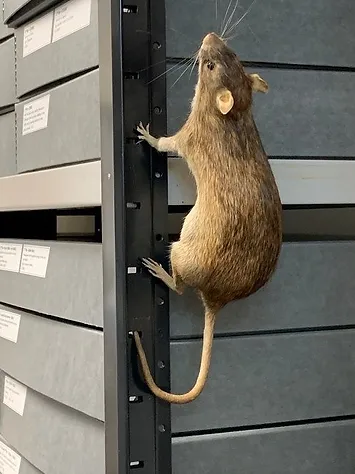
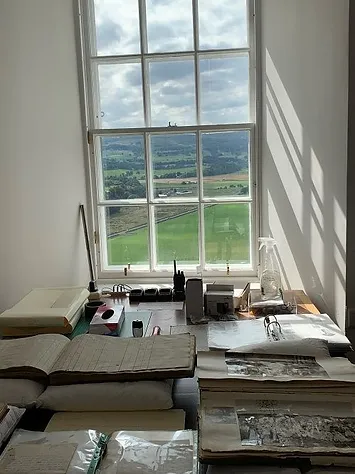
Our tour of the facilities took in both the Archive store, where we encountered 'Rod the trench rat' - a former exhibit of the Regimental Museum who now keeps a beady eye on the collections in the store - and the work room, which offers spectacular views of the grounds below the Castle. The work room holds reference publications on military uniforms, newspaper cuttings concerning the regiment, photographs of gravestones associated with the regiment, reference material on medal holders and World War II citations for bravery medals, information on military pipe bands and pipe majors, and records of pipe tunes.
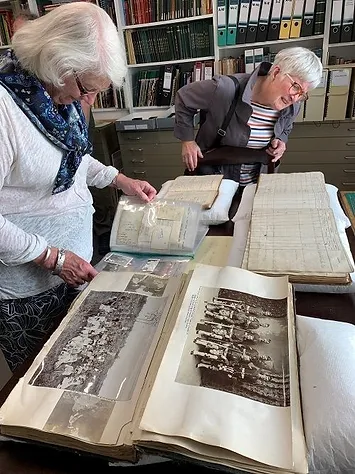
During our tour, Rod showed us some fascinating treasures from the collection, including examples of trench maps, regimental photographs and watercolours, war diaries, and regimental magazines. In the first nominal roll book of the Argyll and Sutherland Highlanders, Rod pointed out the regiment's youngest member: a drummer boy named James Ross, who enlisted in 1813 at the age of 9. We were also moved by a poignant collection of documents and photographs relating to Private James Weir Baird, who served with the regiment's 6th (Renfrewshire) battalion in World War II. Baird was captured by the Germans in 1940, and the collection includes his letters home, as well as a letter from Baird's father to the regiment, asking if his son had died in service. Baird was released several years later, but sadly his father died whilst he was in captivity, and they were never to be reunited. He had carried a photograph of his parents with him throughout his time in the Prisoner of War camps. Baird also worked as a POW on a German farm, where he had a favourite cow; he got on well with the farmer, who gave him the cow's ear tag when it died. This tag, as well as Baird's own POW tag, forms part of the collection.
Our visit concluded with an opportunity for us to individually explore the recently redeveloped Regimental Museum. Organised on three levels, it contains themed gallery spaces that focus on the social aspects of the regiment's history, the overarching aim being to tell the 'soldier's story' through the personal objects of individual members of the regiment. The Museum also highlights the regiment's strong bonds with two of its Royal Colonels-in-Chief: Princess Louise, Duchess of Argyll, who became Colonel-in-Chief in 1872, and Queen Elizabeth II, who was appointed as Colonel-in-Chief on her 21st birthday in 1947 and maintained a close relationship with the regiment until her death in 2022. Personal memorabilia relating to both Princess Louise and Queen Elizabeth II is on display in the Museum galleries. For opening hours and for further information on the Museum, please see: https://argylls.co.uk/museum/.
We would like to thank the Chief Executive Officer of the Museum, Harvey Carruthers, for facilitating our visit, and are particularly grateful to Rod MacKenzie for giving so generously of his time, knowledge and enthusiasm.
SRA Summer Visit to Edinburgh Academy Archive, June 2022
Originally planned for summer 2020 but postponed due to the pandemic, the Association's visit to the Edinburgh Academy Archive finally took place on 14 June 2022. Located on the Senior School Campus at 42 Henderson Row, the archive holds the Academy's official administrative records as well as a rich variety of photographs, artefacts and personal memorabilia of former pupils and staff: https://www.edinburghacademy.org.uk/859/ea-archives.
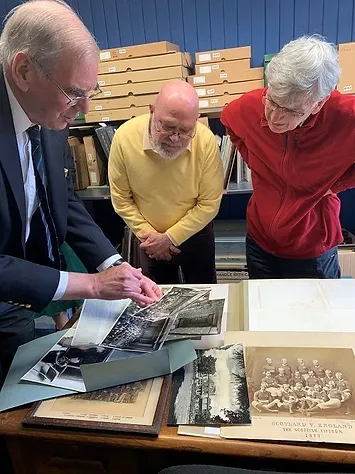
Our small but enthusiastic group was welcomed by the Honorary Archivist, Andrew McMillan (pictured above, showing a photograph to two members of the group), the Director of Development and Alumni Relations, Samantha Byers, and the Bursar, Guy Cartwright. Andrew began by giving us an illustrated talk on the history of the school, whose origins date back to 1822. The Academy was founded by two Edinburgh lawyers, Henry Cockburn (later Lord Cockburn) and John Russell, and an educational reformer, Leonard Horner. Perceiving a need for a new school that would provide a classical education, they, with the backing of some 160 subscribers, developed a Scheme and communicated their intentions to the Lord Provost, but had to work to gain approval for what the Town Council saw as a rival proposition to the long-established Royal High School of Edinburgh. Eventually the founders prevailed, and the Academy opened its doors on 1 October 1824. Initially, only boys were accepted as pupils, but from the 1960s small numbers of girls were admitted to study for A Levels. The school became fully co-educational in 2008.
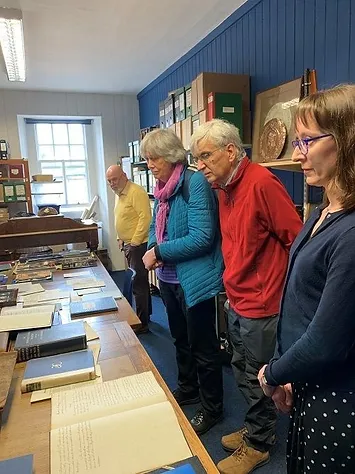
After some refreshments, we were then shown upstairs to the Archive, which is housed within five attic rooms. In the 'Treasures Room', (pictured above), Andrew had prepared a fascinating display of items including the first minute book of the Directors of the Academy; an original letter by Sir Walter Scott, one of the first Directors; an example of a 'Class Club album,' containing photographs of every pupil within an individual class and their teacher; a notebook recording stage directions for school plays; the prize medals of W.J. Stuart, a pupil at the school from 1883-1891, including his gold Dux medal; and the first minute book of the former pupils' association, the Edinburgh Academical Club, established in 1828. As Andrew explained, the school has an illustrious roll of former pupils, such as the eminent physicist, James Clerk Maxwell; the renowned author, Robert Louis Stevenson; Viscount Haldane, founder of the Territorial Army; and the journalist and broadcaster, Magnus Magnusson, who published a history of the Academy in 1974.
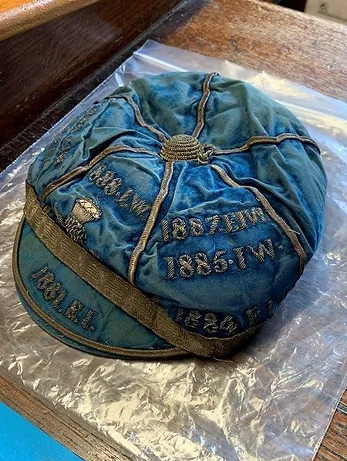
The archive also documents the importance of rugby in Academy life since the 1850s. The school's matches against Merchiston, which commenced in 1858, are believed to be the oldest continuous run of fixtures in the world, and the Academy has produced more Scottish internationalists than any other school. A particular highlight of the collection, (pictured on above), is a Scotland cap awarded to former pupil, Charles 'Hippo' Reid, recording the rugby matches in which he played. Reid was a 17-year-old Academy boy when selected for a fixture against England in 1881 and remains the second-youngest player ever to be capped for Scotland.
Fortunately for researchers who do not live locally, some of the documents in the archive are now digitised and available for consultation online, Andrew and his colleagues having established the Edinburgh Academy Digital Archive for this purpose in 2020: https://edinburghacademy.cook.websds.net. The Digital Archive currently contains scanned records relating to the school's foundation, as well as a run of The Edinburgh Academy Chronicle from 1893 to 2010, The Edinburgh Academy Register 1824-1914, and The Edinburgh Academy War Service Record 1939-45. In the next phase of development, Andrew plans to scan and upload a selection of photographs from the collection.
Our enjoyable visit concluded with a guided tour of the Senior School Campus, taking in its ornate assembly hall designed by William Burn; the gymnasium, which is the Academy's war memorial, paid for by Academicals and friends and dedicated in 1923; and the gardens (acquired together with the buildings by the Academy from Donaldson's School in 1977), in which scenes for The Prime of Miss Jean Brodie (1969) were filmed. We would like to thank Andrew McMillan, Samantha Byers and Guy Cartwright for their hospitality and for giving so generously of their time, knowledge and enthusiasm.
SRA Summer Visit to Glamis Castle and Archives, September 2019
On 6 September, twelve members and guests of the Scottish Records Association spent a fascinating day at Glamis Castle, family seat of the Earls of Strathmore and Kinghorne. The group was welcomed by the Castle Archivist, Ingrid Thomson, who gave an introductory talk about the family's history and the development of the Castle from its origins in the 1400s to its use as a convalescent home for servicemen during World War I. Opened to the public in 1950, Glamis Castle is best known today as the childhood home of Lady Elizabeth Bowes Lyon, daughter of the 14th Earl of Strathmore and Kinghorne, who ultimately became Her Majesty Queen Elizabeth the Queen Mother. She and her husband, Prince Albert, the future King George VI, spent part of their honeymoon at Glamis and their younger daughter, Princess Margaret, was born there.
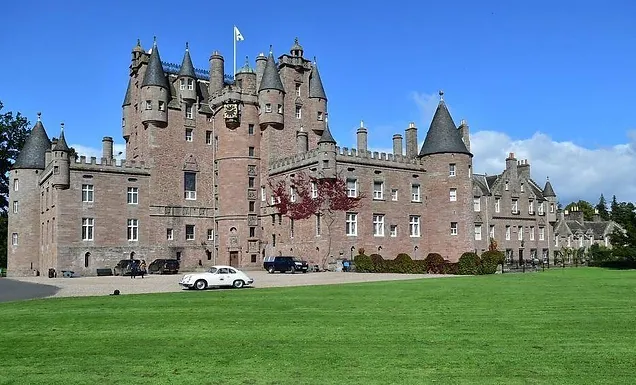
Reproduced with the permission of Glamis Castle
Having conquered the climb of 91 spiral steps up to the Archives, the group was rewarded with a display of treasures from the collection, arranged by Ingrid, which included the Archives' oldest item: a 12th century Charter by William the Lion in favour of the church of St Peter of Restennet, near Forfar of the lands of 'Ardnequere'. Ingrid also showed a Papal Bull signed by Pope Gregory 11th at Avignon in 1375, relieving the perpetual vicar of Glamis of paying an annual pension on lands he handed back; a menu book of 1876, emphasising the difference between the refined meals served to the family 'upstairs' and the plainer fare consumed by the servants 'downstairs'; several game books, beautifully illustrated by various contributors, including Lady Elizabeth Bowes Lyon's brother, Michael; Lady Elizabeth Bowes Lyon's passport, and an autograph book dating from World War I. Lady Elizabeth stayed at Glamis during the war and this poignant volume contains sketches and verses dedicated to her by the injured servicemen who were taken there to convalesce.
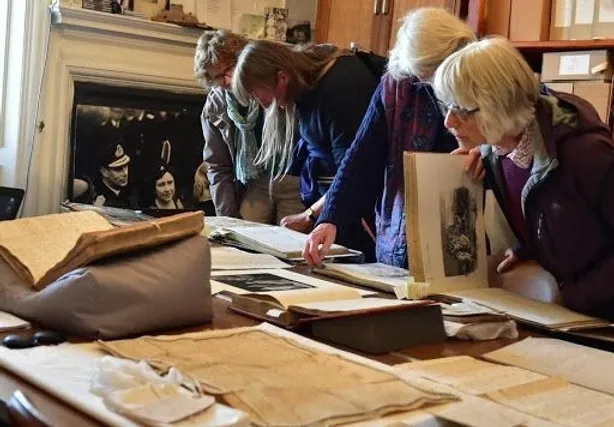
Reproduced with the permission of Glamis Castle
Ingrid also displayed several items of historical clothing including a man's embroidered waistcoat of 1710, probably worn by the 5th Earl, which was discovered in a trunk in the Castle drawing room in the 1980s.
During the lunch break, some of the group browsed the Castle's latest exhibition, which celebrates the inspiring women of Glamis. Featuring many records and photographs from the Archives, this was much enjoyed by everyone lucky enough to see it. Details of the exhibition can be found on the Castle website: https://www.glamis-castle.co.uk/event/the-women-of-glamis-exhibition/.
In the afternoon, Castle Guide, Chris Currie led a tour of the building, beginning with the grand dining room. Pointing out the lions incorporated into the décor, Chris explained that the Bowes Lyon family probably originated from Lyon, France, hence the family symbol is the lion, which is also the symbol of Lyon. In the earliest part of the Castle, dating from the 1400s, Chris drew attention to a scold's bridle, and the saddle reputedly used by Bonnie Prince Charlie during the 1745 Jacobite Rising. The drawing room contains a striking portrait by the Dutch artist Jacob de Wet, of Patrick, 3rd Earl of Kinghorne, wearing a set of flesh-coloured, leather body armour. When the Castle was inherited in 1646 by two-year-old Patrick, it was in a ruinous state. Patrick grew up, embarked upon extensive rebuilding and renovations, and by the end of his life had succeeded in reviving the family's fortunes.
The family's private chapel, which was furnished and consecrated in 1688, contains no fewer than 94 paintings by Jacob de Wet which adorn its walls and ceilings. The chapel is still in use and a service takes place there every second Sunday. Chris added that the chapel is haunted by the ghost of Janet Douglas, Lady Glamis, who was accused of treason and burnt at the stake in 1537. Known as 'the Grey Lady', she is apparently often seen praying in the chapel. The Castle's Royal sitting room also has its own ghost: a page boy who sits on a stone seat just inside the door, waiting to trip up unsuspecting visitors.
The Royal bedroom, where Lady Elizabeth Bowes Lyon and her husband, Prince Albert, spent their honeymoon, contains a cot made by the Dundee Lord Roberts Memorial Workshop for Princess Elizabeth, which was subsequently used for Princess Margaret. Chris also explained that the King's dressing room boasts the oldest bed in the Castle, the 'Kinghorne bed', which dates from the 17th century and was made for Patrick, the 3rd Earl. At that time, people slept sitting upright in bed, rather than lying down, hence the bed's small size. The tour concluded with the Castle guardroom, where a stuffed and mounted Canadian brown bear named Fred was on display. The (live) bear was reputedly bought by the 13th Earl as a pet, but met an unfortunate end in a field full of Highland cows and the family were so attached to him that they decided to have him stuffed.
The enjoyable, sunny day was completed by exploring the Castle's extensive grounds, which incorporate a Pinetum, a Walled Garden and an Italian Garden, as well as a memorial to Princess Margaret. The SRA would like to thank Ingrid Thomson and Chris Currie for hosting the visit and for giving so generously of their time, knowledge and enthusiasm.
SRA Summer Visit to Glasgow, June 2019
On 14 June, nine members and guests of the Scottish Records Association spent an enjoyable day visiting two repositories in Glasgow. The morning destination was the Trades Hall, home to the Trades House of Glasgow Library and Archives. The Trades House of Glasgow was established in 1605 to help protect and support the city's craftspeople, and the Trades Hall, which was designed by Robert Adam and constructed between 1791 and 1794, is the second oldest building in Glasgow still being used for its original purpose. The Honorary Librarian, Carol Parry, and the Honorary Archivist, Craig Bryce, gave a tour of the building. Passing through the Deacon Convener's Room, the Craftsman's Gallery Museum, the Saloon and the Grand Hall, Craig pointed out several significant artefacts and decorative features, including a gold silk frieze woven by Belgian artists and installed in 1903, which runs around the entire perimeter of the Grand Hall and has depictions of all 14 Incorporated Trades of Glasgow.
Refreshments were taken in the Library, which, as Carol explained, was established in 1897 and comprises books relating to the crafts, plus books relating to Glasgow, to Scotland as a whole, and to Robert Burns. It also houses the Old Glasgow Club's Library and the Colquhoun Library of the Junior Chamber of Commerce. The Library is open to the public by appointment and complete lists of the books and periodicals held, along with digitised/transcribed versions of some of the earliest records of the Trades House, are available on the Trades House Digital Library website: https://www.tradeshouselibrary.org/. Carol displayed some highlights from the collection, including a bound volume of the Glasgow periodical, The Bailie, which is a rich source of information about prominent individuals in the city in the late nineteenth and early twentieth centuries; a copy of The Modern Builders Guide by Alexander Hay, Architect (1841), which was dedicated to the Deacon Convener and Collector of the Trades House and consists of 'a series of practical drawings with Letter press Descriptions'; and a copy of the New Testament for the Use of the Blind printed by the Glasgow Blind Asylum at the Institution Press in 1837. The volume's type, (a precursor to Braille), known as Alston Type, was developed by the Glasgow muslin manufacturer John Alston (1778-1846), who had a close association with the Trades House and was Deacon of the Weavers (1810-11) and Deacon Convener (1829-30). The Library's copy was dedicated to the Trades House by Alston 'as a small mark of respect'.
In the basement of the building are the Trades House Archives. Craig explained that the earliest records relating to the Trades House are actually located in the Mitchell Library, but the on-site collection includes records of feu duties, letter books, cuttings and photographs. There is also a substantial collection of vouchers and receipts and these interesting documents are currently being transcribed and added to the Trades House Digital Library website. The visit concluded by exploring some of the Archives' treasures: a selection of records relating to the administration and property of the Trades House; a large volume of photographs of 19th century Deacons compiled by the Association of Deacons; and several items from the archives of the Old Glasgow Club, including a fascinating nineteenth century police record book.
After lunch the group made the short journey to the West End to visit the National Library of Scotland Moving Image Archive, located within the recently refurbished Kelvin Hall. The Acquisitions Curator, Kay Foubister, explained the history and development of the collection. Initially known as the Scottish Film Archive, it was established in 1976 under a Government job creation scheme but, following some television appeals for donations of film, the collection expanded rapidly. From 1997, the collection was known as the Scottish Screen Archive. It became part of the National Library of Scotland in 2007 and now holds 46,000 items of film and video documenting Scottish life, society, industry and culture. The earliest moving image in the collection dates from 1896 and features Queen Victoria with the Tsar of Russia at Balmoral. The Archive also includes a comprehensive library of Gaelic television output since January 1994, and a collection of manuscripts, printed material and memorabilia relating to the history of film production and cinema-going in Scotland since 1896.
The Archive takes in between 1,000 and 2,000 items per year, including donations from local authorities, universities, businesses and individuals. Kay pointed out that appraising these new accessions is a lengthy process because she has to view every single film all the way through, making notes as she goes so that she does not have to risk playing the film twice. Footage often arrives with little or no accompanying information, particularly if it has been donated following a bereavement. Donors also sometimes have hazy or false memories of what their films contain, while the labels on home video cassettes may be inaccurate as people tended to tape over the original contents.
Kay then gave a guided tour of the Archive's environmentally-controlled stores, which consist of several different vaults. There is one vault for the quarantine of films affected by fungus; another vault for storing films affected by vinegar syndrome, and a further vault for the separate storage of 'dirty film' that is contaminated with dust and dirt. The Archive's technical areas include in-house facilities for digitising film, with the exception of 35-millimetre film. Kay explained that she and her colleagues salvage old video equipment, including broadcast and domestic machines such as VHS and Betamax video recorders, to use for digitisation. They are always pleased to hear from anyone who is willing to donate such equipment: donatemovingimage@nls.uk.
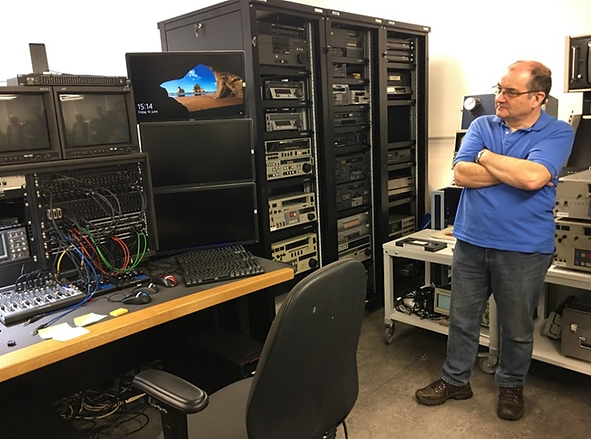
Lastly, the group spent a little time exploring the Archive's public access centre. This boasts an attractive display of film-related artefacts as well as a 12-screen video wall and interactive touch screens on which around 3,000 films from the collection can be viewed.
More than 2,000 clips and full-length films are available to view remotely via the Moving Image Archive online catalogue https://www.nls.uk/collections/moving-image-archive, and it is also possible to hire or buy DVD copies of footage from the Archive. Anyone wishing to conduct specialist research or to consult the written material in the collection is welcome to do so by appointment. Contact: movingimage@nls.uk.
The Scottish Records Association would like to thank Carol Parry, Craig Bryce and Kay Foubister for hosting the visits and for giving so generously of their time and expertise.
SRA Summer Visit to Perth, June 2018
On Friday 22 June, eight members and guests of the Scottish Records Association were privileged to explore two fascinating repositories in Perth: Perth and Kinross Council Archive and the Royal Scottish Geographical Society. The former's current premises, the A K Bell Library, opened in 1994. The archivist, Ishbel MacKinnon, led a behind-the-scenes tour of the Archive store, which boasts an air conditioning system that can both humidify and dehumidify; a dual functionality that is unusual to find in Scotland. The largest single collection in the Archive is the Perth burgh records, with one quarter of the ground floor storage space given over to them. Ishbel also highlighted the records of the recently redeveloped Perth Theatre. The theatre's education and outreach officer regularly makes use of this collection, which was catalogued by an intern in 2017.
As well as looking after the historic records of the two counties of Perth and Kinross, the Archive has a collecting role, with around 40 percent of its holdings coming from local businesses, families and other external sources. Its largest estate collection is the Threipland papers (Carse of Gowrie).
Most of the maps and plans held in the Archive are to be found within the Perth burgh and county council records, including some estate plans (presumably because the Council had acquired the properties concerned). The group was particularly taken by a plan and south front elevation of Smeaton's Bridge (c1795), a stone bridge constructed over the River Tay at Perth from the tenter at the North Inch to the opposite shore. John Smeaton is known as the 'father' of civil engineering, and Perth Bridge is considered to be one of his greatest achievements. At the time, it was the longest bridge in Scotland.
The Archive also holds some materials from the Munro Society Archive, which were deposited in 2003. Membership of the Munro Society is open to walkers who have climbed all 282 Munros (a Munro is a Scottish hill of over 3000 feet or 914.4 metres in height). The collection incorporates members' personal papers and photograph albums, plus material relating to the Society's involvement with conservation and management matters. Also included are records of the Heightings Project, in which Society members participated. The project involved checking the heights of Corbetts and Munros that were previously found to be within 4 metres of 914.4 metres, to see if any should be re-categorised to a different status.
In the afternoon, the group visited the Royal Scottish Geographical Society (RSGS). In the Shackleton Room (named after the polar explorer, Sir Ernest Shackleton, who became the first full-time, paid Secretary of the RSGS in 1904), the group was greeted by the Convener of the Collections Committee, Margaret Wilkes; the RSGS's Writer in Residence, Jo Woolf; and Andrew Cook, Consultant Archivist. Margaret explained that the RSGS is not a branch of the Royal Geographical Society, but an independent Scottish society, founded in 1884 to support and promote geographical education, research and exploration. Having formerly been based in Edinburgh, and then at the University of Strathclyde, the RSGS headquarters relocated to Lord John Murray House in Perth in 2009. Its visitor centre, which opened in 2011, is situated next door within the Fair Maid's House, the oldest secular building in Perth. The RSGS has no permanent curator, but its historical records, which date back to 1884, are looked after by Margaret and a team of 10 regular volunteers. Since 2015, the collection has also benefitted from the attentions of Jo, who has been delving through the records for hidden gems and bringing them alive via blog posts, articles in History Scotland magazine, and a book entitled The Great Horizon: 50 Tales of Exploration, highlighting some of the notable explorers connected with RSGS.
Margaret and one of the RSGS volunteer guides, Anne McKillop, then led a tour of the Visitor Centre. Connected to Lord John Murray House by a link room, the ground floor incorporates a Reception Room, an Education Room and an Earth Room. There is also a garden space dedicated to James Croll (1821-1890), a former Janitor of Anderson's University (now the University of Strathclyde), who rose from humble beginnings to develop ground-breaking theories on climate change. Upstairs is the Explorers' Room, where objects ranging from the cap and polar medals of William Speirs Bruce, Scientist on the 1902-1904 Scottish Antarctic Expedition, to lumps of fossilised dinosaur droppings can be seen. Meetings of the Perth Glovers' Society were once held in this room, which also contains one of the original 15th century features of the Fair Maid's House: a prayer niche, which would have been used for Bible study, prayer and quiet reflection.
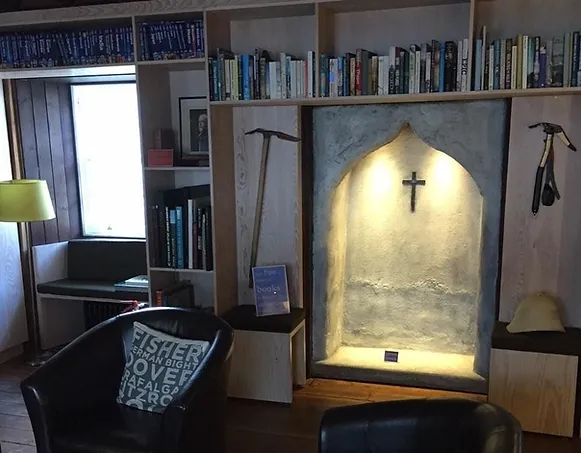
The visit concluded by browsing a display of treasures from the archive collection, chosen by Margaret, Andrew and Jo. These included two British, War Office-produced military plans showing the positions of the opposing forces in Western Europe at the cessation of hostilities in 1918. Both plans are autographed by Field Marshal Douglas Haig (1861-1928), Commander in Chief of the British Armies in France, who personally gifted them to the RSGS. Also on display were letters written by Harry Goodsir, who was Assistant Surgeon on Sir John Franklin's 1845 expedition to discover a Northwest Passage through the Arctic. The expedition ended in tragedy for all involved, becoming the worst disaster in the history of British polar exploration. Harry Goodsir's sister, Jane, kept these letters as part of the family archive, which eventually came to the RSGS during its 50th anniversary year. Members of the group were also interested by a photograph album containing images of RSGS Council Members from 1897 onwards, including many influential people of the time, such as the town planner, biologist and sociologist, Patrick Geddes. Other fascinating items included a hand-drawn tracing of the intended route of Ernest Shackleton's ship, 'Endurance', during the Imperial Trans-Atlantic Expedition of 1914-1917, autographed by Shackleton; and an evocative watercolour of a funeral procession in Umanak, Greenland, painted in 1929 by Isobel Wylie Hutchison (1889-1982). Born in West Lothian, Hutchison was a botanist, painter and writer who travelled widely, particularly in the Arctic, following the First World War. She recorded these Arctic journeys in her diaries, watercolour sketches, films and slides, and also produced numerous travel books.
The Scottish Records Association would like to thank Ishbel MacKinnon of Perth and Kinross Council Archive, and Margaret Wilkes, Jo Woolf, Andrew Cook and Anne McKillop of the Royal Scottish Geographical Society for hosting the visits and for giving so generously of their time, enthusiasm and expertise.
SRA Summer Visit to Edinburgh, September 2017
On Monday 11 September, 14 members and guests of the Scottish Records Association set out to explore two fascinating library and archive facilities in Edinburgh. Our morning destination was Ingliston House, home of the Royal Highland and Agricultural Society of Scotland (RHASS). There we received refreshments and an introductory talk from the Librarian, Sheila Miller, before being taken in small groups for a tour of the Library stores.
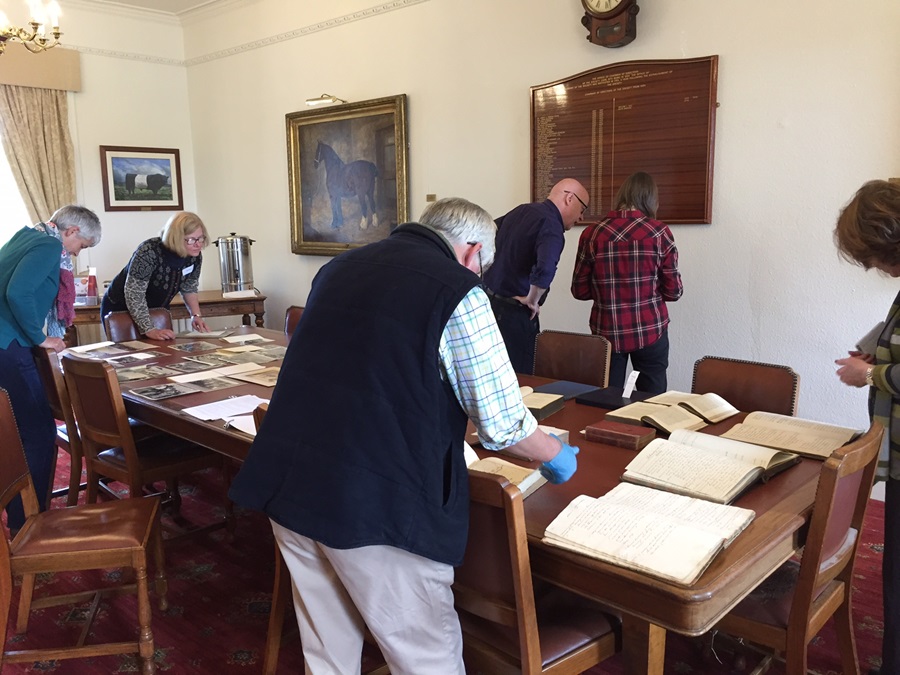
The RHASS was established in 1784 and originally aimed to improve conditions throughout the Highlands and Islands of Scotland by promoting the advancement of agriculture, the introduction of useful trades and manufactures, and the improvement of roads and bridges to facilitate better communication. It also strove to preserve the Gaelic language and the poetry and music of the Highlands.
Consequently, the RHASS Library comprises an enviable collection of antiquarian books and pamphlets on various aspects of agriculture and husbandry, as well as on Highland customs, society and language. It also holds several significant manuscript collections, notably a unique set of correspondence relating to the compilation and publication of the Gaelic Dictionary, in which the RHASS was closely involved, and correspondence relating to the establishment of the Royal (Dick) School of Veterinary Studies.
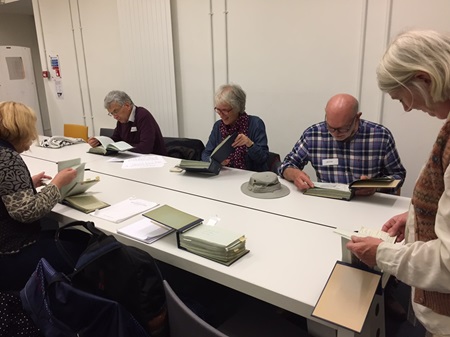
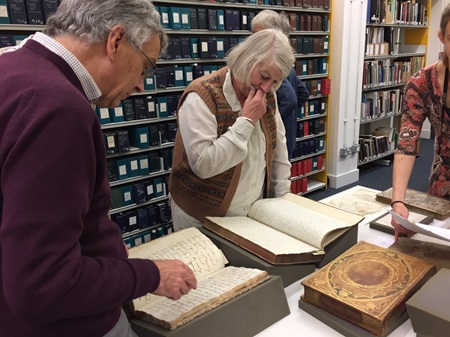
Sheila had kindly laid out a selection of items from the Library for members and their guests to browse on returning from their tour. Among the most interesting of these was a contemporary map of Belgium, showing the districts in which the Agricultural Relief of Allies Committee had distributed gifts of cattle, goats, sheep, poultry and pigs following the First World War, and a manuscript copy of James Watt's Survey of the Proposed Canals at Crinan and Tarbert (1772), autographed by Watt.
Following a splendid lunch in the RHASS Boardroom, we travelled into central Edinburgh to visit the Scottish Life Archive's search room at the National Museum of Scotland in Chambers Street. As Senior Curator, Dorothy Kidd, explained to us, the Scottish Life Archive was established in 1959 and seeks to collect, record and preserve evidence of Scotland's social history and material culture. While the collections themselves are stored in Granton, the bright and modern search room holds hundreds of ring binders that were originally developed as a finding aid to the collections for Museum staff. Arranged by subject and then by county, each binder contains a wealth of bibliographical references, newspaper cuttings, dictionary definitions, references to photographs and objects in the collections of the National Museum of Scotland and elsewhere, extracts from oral testimonies, and so on.
The search room also houses the National Museum of Scotland's Research Library, and the Library Services Manager, Mark Glancy, gave us a brief introduction to this facility. The Library started in 1781, and aims to collect material covering the same subjects and research areas as the Museum. It also holds the Museum's own institutional archive.
We were then encouraged to spend time exploring the binders, and to browse an intriguing selection of original materials that Dorothy and Mark had arranged for us. These included the first minute book of the Society of Antiquaries of Scotland (founded in 1780); the manuscript diary of A. Forbes Mackay, which records his experience as the junior member of the three-man party that reached the South Magnetic Pole on 16 January 1909; a volume of 38 original, coloured drawings of birds of the Southern Hemisphere, executed from the life, in the course of Captain Cook's second voyage (artist not known); and a copy of Jenners department store's catalogue for Christmas 1913.
Our enjoyable afternoon concluded with a welcome cup of coffee and cake in the National Museum of Scotland's café. One or two members then took the opportunity to look around the Museum's galleries on their way home.
The Scottish Records Association would like to thank Sheila Miller of the Royal Highland and Agricultural Society of Scotland and Dorothy Kidd, Mark Glancy and Georgia Rogers of the National Museum of Scotland for hosting us, and for giving so generously of their time, expertise and hospitality.
SRA Summer Visit to Inveraray, Friday 23 June 2017

Our small but enthusiastic group of SRA members and guests thoroughly enjoyed a trip to Inveraray Castle, family seat of the Dukes of Argyll, on 23 June. Arriving first at the Argyll Estates Archives, we received a cup of tea and a warm welcome from the Archivist, Alison Diamond, and her volunteer, Duncan Beaton.
We then walked the short distance to the Castle for lunch in the Tea Room and a tour of the Private Apartments courtesy of Elspeth Guyan, Castle Guide. Among the various tapestries and family portraits hanging in the well-appointed rooms, everyone admired a full-length portrait of society beauty Elizabeth Gunning, who married John Campbell, 5th Duke of Argyll in 1759. The Private Apartments also contain Elizabeth's richly furnished bed, which stands so tall that it could only be accommodated in its present space by removing a decorative vase from the top of its canopy (the vase is now displayed elsewhere in the Apartments).
Alison then became our guide for a tour of the public areas of the Castle, where the artefacts on display include the dress worn by Queen Victoria's daughter, Princess Louise, at her wedding to the 9th Duke of Argyll in 1871, and a charming pair of the Princess's baby shoes. The group was particularly taken with the Castle's ornate dining room in which a special Christmas episode of the television series Downton Abbey was filmed in 2012.
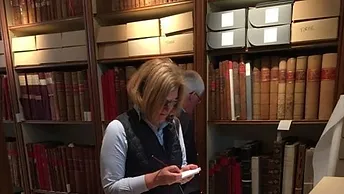
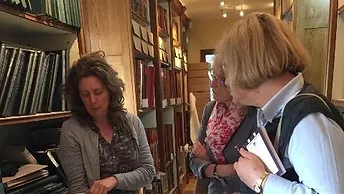
Returning to the Archives, we ended our afternoon with a fascinating tour of the reading room and two storerooms. The family and estate papers of the Campbells, Dukes of Argyll date back to the 1300s and we were privileged to see some of the treasures of this vast collection, including the Rental of the Bishopric of Argyll dating from 1624, and a most interesting volume of 'Letters and Instructions for building Inverara Castle for His Grace the Duke of Argyll in Argyllshire', drawn up in the mid-1740s. The group also admired a selection of cartoons drawn by Lord Archie Campbell, and puzzled over the handling challenge posed by a vast bound volume of illuminated addresses to Lord Lorne (the future 9th Duke of Argyll) and Princess Louise on the occasion of their marriage.
The Scottish Records Association would like to thank Alison Diamond, Duncan Beaton and Elspeth Guyan for making our visit possible and for giving so generously of their time and expertise.
Summer Visits 2016
This summer, SRA members and their guests enjoyed guided tours of two repositories in Perth and a further two in Glasgow. On Friday 17 June, 14 members and guests spent the morning exploring the Fergusson Gallery, Perth's former Waterworks building which now houses the artwork and personal archives of the Scottish Colourist, John Duncan Ferguson (1874-1961) and his partner, Margaret Morris (1891-1980). After viewing a display of Fergusson's paintings and sculptures in the lower gallery, the group proceeded to the upper gallery where a new exhibition marks 125 years since the birth of Margaret Morris. Morris not only devised her own, distinctive technique for teaching dance, but was also a composer of dance music; a costume designer; a playwright, and an artist in her own right. The exhibition features a vibrant array of photographs, paintings, costumes and other memorabilia relating to her career. The group concluded their visit with a tour of the artwork storage area and the Gallery's newly opened research room, where they took full opportunity to examine the exhibition catalogues, items of personal correspondence and other archive records in this unique collection.
In the afternoon, the group received a behind-the-scenes tour of the collection stores at the neighbouring Perth Museum and Art Gallery. This began with highlights from the Museum's photographic collection, including daguerrotypes and glass plates from the earliest days of photography; street scenes and picturesque views captured by prominent local photographer, Magnus Jackson (1831-1891), and charming original photographs of Beatrix Potter's pet rabbit, 'Benjamin Bouncer'. The tour then took in several other themed stores, with the group particularly enjoying the stuffed birds and animals in the natural history collection, the household accoutrements in the social history store, and the national treasures in the paintings store. The tour concluded with some examples of the archive records held in the Museum, including ephemera relating to Miss Georgina Ballantine, who, on a fishing trip near Caputh on 7 October 1922, landed the heaviest British rod-caught salmon. The Museum recently acquired a written account of Miss Ballantine's tussle with the 29-kilogram fish, plus an advertising bill for the Perthshire Advertiser, proclaiming her record-breaking catch. These items are to be placed on display beside a fibreglass model made from an original plaster cast of the salmon.
On 12 September, 8 members and guests visited the Glasgow Women's Library, which celebrates its 25th anniversary this year. They received an illustrated talk on the history of the Library and its archive collections, followed by an opportunity to see and handle some of the diverse items from the archives. These ranged from Suffragette postcards, to knitting and dressmaking patterns and editions of the 'Jackie' annual, the latter proving a nostalgic highlight for many in the group. The visit concluded with a tour of the building's purpose-built archive stores, and a short talk about the Library's current Heritage Lottery Fund project to record and share the history of Women's Aid in Scotland.
The group then travelled the short distance to the Scottish Jewish Archives Centre in Garnethill Synagogue. Their visit began with a guided tour of the synagogue, which opened in 1879 and is the oldest in Scotland, before taking in the archive stores. Members and their guests received an illustrated talk about the archive collections, and spent time exploring the fascinating displays of photographs, artefacts and other personal records relating to Jewish families in Scotland. They also learned of the SJAC's plans to create a new Scottish Holocaust Era Study Centre.
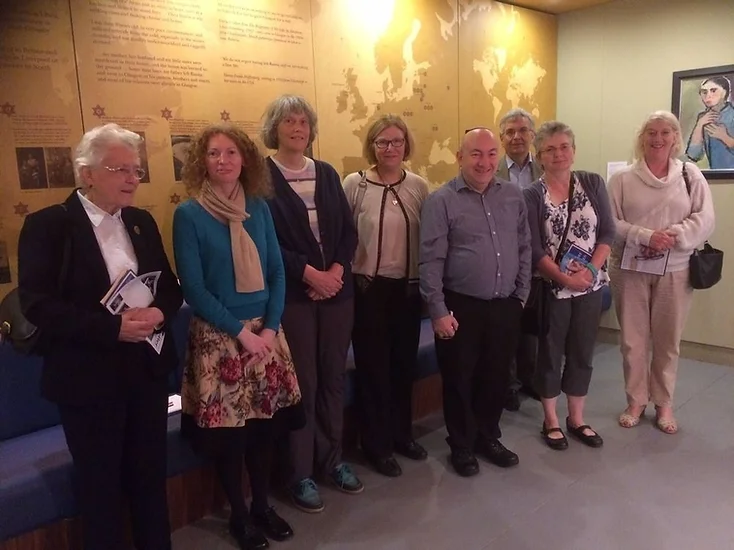
We would like to thank Amy Waugh of the Fergusson Gallery; Mark Simmons and Paul Adair of Perth Museum and Art Gallery; Nicola Maksymuik and Elizabeth O'Brien of the Glasgow Women's Library, and Harvey Kaplan of the Scottish Jewish Archives Centre for hosting this year's visits and for giving so generously of their time and expertise.
Summer Visits 2015
The Association was pleased to offer members the opportunity to visit four outstanding repositories in Edinburgh and Glasgow during the summer. The first visit, to two historic legal libraries in Edinburgh, took place on Monday 8 June. Twelve members and guests enjoyed a comprehensive tour of the Advocates Library in Parliament Square, which was built in 1830 to a design by William Playfair. The tour highlighted the building's impressive cultural artefacts, including a memorial plaque to members of the Faculty of Advocates killed in the First and Second World Wars, and the traditional, individual wooden boxes that are provided for each advocate in the Laigh Hall. As our hosts explained, these boxes are now ornamental, but in former days the advocates' case papers would have been placed there. The Historiographer Royal in Scotland has described the records of the Advocates Library as one of the richest untapped sources for Scottish history in existence, and the group concluded their tour by browsing a display of some of these, including a beautifully drawn family tree from the Arniston Collection.
The group then proceeded to the adjoining Signet Library, where they were treated to a tour of its splendid architectural features. Foremost among these is the cupola in the Upper Library, decorated with a painting of authors and muses including Robert Burns, William Shakespeare and Adam Smith. A display of manuscripts and rare printed material from the Library's collections had again been provided, including a fascinating scrapbook of original documents relating to the case of Oscar Slater, who was wrongfully convicted of murdering Marion Gilchrist in Glasgow in 1908. The group also examined what is believed to be the last original manuscript leaf from the journals of circuit judge, Lord Cockburn: his nephew was understood to have burned all the manuscripts after the journals were published, but one page has fortunately survived. This records Cockburn's suggestions for the proposed monument to Walter Scott in Edinburgh, expressing his view that Edinburgh was not a proper place in which to erect an obelisk as the city was more suited to chimneystacks!
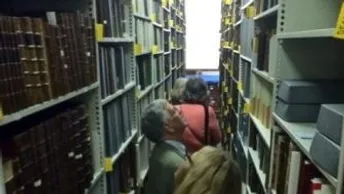
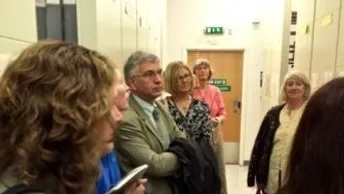
The second double visit, to two performing arts archives in Glasgow, took place on Friday 4 September. Eight members and guests spent the morning at Glasgow University Library Special Collections, home of the Scottish Theatre Archive, where they browsed a selection of the many Scottish theatre posters, playbills, programmes and photographs in its collections. The group took delight in spotting a young David Tennant ('Dr Who'), pictured in one of the performance programmes, and in finding the famous figure of Jimmy Logan, photographed sitting in the front row of a 'full house'. They then received a detailed tour of the Special Collections book store and reading room on the top floor of the Library. The group was thrilled to learn how the social and cultural variety of the special collections at Glasgow University is exemplified by two items housed in a safe in the store: the Hunterian Psalter, which is a 12th century illuminated manuscript, and a kettle that belonged to the mother of the renowned Scottish variety artist, Harry Lauder!
In the afternoon, the group visited the Royal Conservatoire of Scotland Archives. The Conservatoire was initially founded in 1847 as the Glasgow Athenaeum, and was until recently known as the Royal Scottish Academy of Music and Drama. Among the fascinating facts revealed by our host was that the Glasgow Athenaeum was formally opened by Charles Dickens, though the first choice to perform this honour had been a Scottish MP, Lord Morpeth. The group was again privileged to examine a selection of materials from the Conservatoire's collections, including a serpent, a historical musical instrument that is the ancestor of the tuba. Jimmy Logan also figured prominently, as the Conservatoire holds his personal archive. This includes the famous 'red book' received by Logan when he was featured on the television programme, 'This Is Your Life'. The group was surprised to learn that when each subject was handed his or her red book at the end of the programme, the covers were actually empty - they were later filled with content from the evening once filming was over.
The Council of the Scottish Records Association would like to thank Andrea Longson and Jane Condie of the Advocates Library, James Hamilton and Robert Bruce of the Signet Library, Niki Marshall and Claire McKendrick of Glasgow University Library Special Collections, and Stuart Harris-Logan of the Royal Conservatoire of Scotland Archives for hosting this year's Summer Visits and for giving so generously of their time and expertise.
Summer Visits 2014: The Black Watch Museum and Archives, Perth
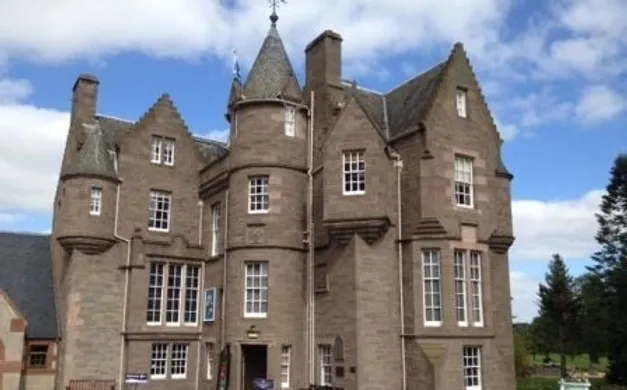
On Monday 1 September, nine members and guests of the Scottish Records Association enjoyed a memorable visit to the Black Watch Museum and Archives at Balhousie Castle, Perth. The visit began with a tour through the recently refurbished museum galleries, each of which explores a particular theme or chronological period in the regiment's history. With origins dating back to 1725, the Black Watch is Scotland's oldest Highland regiment, and our knowledgeable guide, Willie Cooper, regaled the party with stories of the key events, people, and artefacts highlighted in the displays. The impressive selection of military medals prompted several questions from the group, while many found the memorabilia in the First World War-themed gallery, including chalk carvings made by some of the soldiers and a mud-encrusted kilt worn on the battlefield, especially poignant and moving.
The group was then treated to a tour of the archives facility from the Black Watch Archivist, Richard McKenzie. The archival records of the regiment have been housed in Balhousie Castle since the 1960s, and are now located in a new, purpose-built store on the top floor of the Castle, complete with mobile racking. The earliest records in the collection date back to the 1750s, and a selection of eighteenth, nineteenth and early twentieth-century materials was laid out for the group to view. Among the most interesting items were hand-drawn maps and plans associated with the Battle of Loos, letters home from soldiers serving in the First World War, and officers' order books. Richard also spoke about some of the First World War commemorative activities that the museum and archives have planned for the coming years, including a Memorial Wall at Balhousie Castle. From 3 September 2014 and throughout the First World War centenary, a cross will be hung on the Wall for each soldier killed on that day. The names will be read out and the crosses hung during a ceremony at 11am every day during the rest of the centenary period.
There was far more to see than could possibly be squeezed into the time allotted for the tours, and the party enjoyed themselves so much that, at the conclusion of the visit, several people went back into the museum for a second look round. The Council of the Scottish Records Association would like to record their thanks to Willie, Richard, and to the Museum Manager, Emma Halford-Forbes, for facilitating the visit and giving so generously of their time and expertise.
Summer Visit to the Sir Duncan Rice Library, University of Aberdeen
On 6 June, seven members and guests of the Scottish Records Association visited the Sir Duncan Rice Library at the University of Aberdeen. Officially opened in September 2012, the Library was designed as a 21st century space for learning and research, and offers a light, modern and comfortable environment in which to study, as well as spectacular views of the city from the top floor.
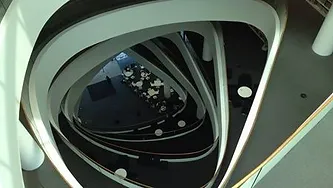
the Sir Duncan Rice Building,
University of Aberdeen
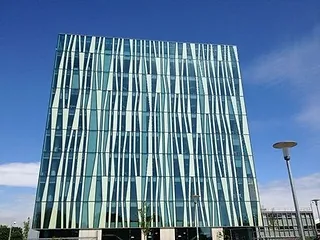
University of Aberdeen
The Deputy Archivist, Andrew Macgregor, delivered a general introduction to the Library and its various collections, followed by a comprehensive tour of the building, beginning with the modern book collections, group study rooms, silent study spaces and flexible learning areas on the upper floors. The group was then shown round the Special Collections Centre, which is located on the Lower Ground Floor and houses the University's historic collections of rare books, manuscripts and archives. The facilities include a Reading Room; a Learning Room - a dedicated area for schoolchildren and other groups to learn more about the collections through workshops, seminars and other educational activities - and the adjacent Glucksman Conservation Centre, which is solely dedicated to conserving the in-house collections. Time was then spent exploring the archive storerooms, including the store in which the pre-1878 portion of the Scottish Catholic Archives, recently transferred to Aberdeen from Columba House in Edinburgh, will be housed. The group was extremely impressed with all the facilities, and Council is grateful to Andrew Macgregor and his colleagues for hosting a most entertaining and enjoyable visit.